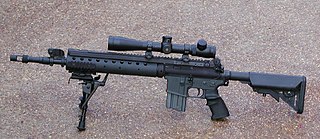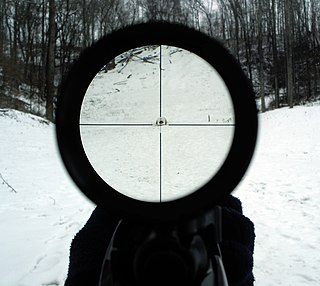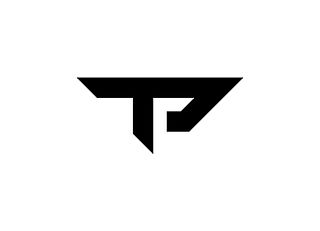
A reticle, or reticule also known as a graticule, is a pattern of fine lines or markings built into the eyepiece of an optical device such as a telescopic sight, spotting scope, theodolite, optical microscope or the screen of an oscilloscope, to provide measurement references during visual inspections. Today, engraved lines or embedded fibers may be replaced by a digital image superimposed on a screen or eyepiece. Both terms may be used to describe any set of patterns used for aiding visual measurements and calibrations, but in modern use reticle is most commonly used for weapon sights, while graticule is more widely used for non-weapon measuring instruments such as oscilloscope display, astronomic telescopes, microscopes and slides, surveying instruments and other similar devices.

The United States Navy Mk 12 MOD 0/1/H Special Purpose Rifle (SPR) is a designated marksman rifle that was in service with United States Special Operations Forces in the designated marksman role until 2017, also designed to be shorter than standard weapons. SPR initially stood for Special Purpose Receiver as it referred to an add-on upper receiver assembly, but that nomenclature changed to Special Purpose Rifle as the weapon became a stand-alone weapons system.

A telescopic sight, commonly called a scope informally, is an optical sighting device based on a refracting telescope. It is equipped with some form of a referencing pattern – known as a reticle – mounted in a focally appropriate position in its optical system to provide an accurate point of aim. Telescopic sights are used with all types of systems that require magnification in addition to reliable visual aiming, as opposed to non-magnifying iron sights, reflector (reflex) sights, holographic sights or laser sights, and are most commonly found on long-barrel firearms, particularly rifles, usually via a scope mount. Similar devices are also found on other platforms such as artillery, tanks and even aircraft. The optical components may be combined with optoelectronics to add night vision or smart device features.

A milliradian is an SI derived unit for angular measurement which is defined as a thousandth of a radian (0.001 radian). Milliradians are used in adjustment of firearm sights by adjusting the angle of the sight compared to the barrel. Milliradians are also used for comparing shot groupings, or to compare the difficulty of hitting different sized shooting targets at different distances. When using a scope with both mrad adjustment and a reticle with mrad markings, the shooter can use the reticle as a ruler to count the number of mrads a shot was off-target, which directly translates to the sight adjustment needed to hit the target with a follow-up shot. Optics with mrad markings in the reticle can also be used to make a range estimation of a known size target, or vice versa, to determine a target size if the distance is known, a practice called "milling".

Raytheon ELCAN Optical Technologies, also simply ELCAN, is a Canadian optics and electronics manufacturing company owned by American defense contractor RTX Corporation, currently based in Midland, Ontario. ELCAN produces optical devices geared towards both civilian and military markets, and their products are sold through Armament Technology Inc. based in Halifax, Nova Scotia, and associated channels of dealers.
Aimpoint AB is a Swedish optics company based in Malmö, Sweden that manufactures red dot sights.
The CheyTac Intervention also known as the CheyTac M200, is an American bolt-action sniper rifle manufactured by CheyTac USA, which can also be classified as an anti-materiel rifle. It is fed by a seven-round detachable single-stack magazine. It is specifically chambered in either .408 Chey Tac or .375 Chey Tac ammunition. CheyTac Inc. states that the system is capable of delivering sub-MOA accuracy at ranges of up to 2,500 yd (2,286 m). It is based on the EDM Arms Windrunner.

The Bor is a Polish bolt-action 7.62×51mm NATO and .338 Lapua Magnum caliber sniper rifle. The weapon received the code name Alex during development, after the name of the lead designer Aleksander Leżucha, creator of the 12.7×99mm NATO Wilk anti-materiel rifle. After the development phase, the rifle received the military designation 'Bor'.
Bushnell Corporation is an American firm that specializes in sporting optics and outdoor products. It is based in Overland Park, Kansas and is a wholly-owned subsidiary of Vista Outdoor. Bushnell makes binoculars, telescopes, spotting scopes, riflescopes, red dot sights, GPS devices, laser rangefinders, game cameras, night-vision devices and other optical equipments.

Întreprinderea Optică Română, often abbreviated by the acronym IOR, is a major optics company established in 1936 in Bucharest. IOR produces military and civilian-grade optics and associated equipment for export and domestic production. The company is known in North America particularly for its riflescopes, binoculars and other sporting optics, which often accompany Romanian military equipment sold on the North American market, such as the PSL rifle.

The C79 Optical sight is a small arms telescopic sight. Elcan names it as the SpecterOS3.4x, but in Canadian service, it is typically referred to as the C79 or the C79A2. A variant, the M145 Machine Gun Optic is in use by the US military. It is 3.4×28, meaning 3.4x magnification, and a 28mm diameter objective lens. A tritium illuminated reticle provides for normal and low-light conditions sighting. It can be mounted to a variety of rifles and light machine guns using the M1913 Picatinny rail mounting system or the similar "Diemaco" rail system found on small arms produced by Diemaco/Colt Canada. It is manufactured by Elcan and can be found on military service weapons around the world. Similar rifle sights are the Sight Unit Small Arms, Trilux (SUSAT) and the Advanced Combat Optical Gunsight (ACOG).
Leupold & Stevens, Inc. is an American manufacturer of telescopic sights, red dot sights, binoculars, rangefinders, spotting scopes, and eyewear located in Beaverton, Oregon, United States. The company, started in 1907, is on its fifth generation of family ownership.
Schmidt & Bender is a German company specialized in producing high-end telescopic sights for hunting, sports, law enforcement and military arms.

The FR F1 is a French sniper rifle manufactured by the Manufacture d'armes de Saint-Étienne (MAS); one of several government-owned arms factories in France. The FR F1 was France's first purpose-built precision rifle for sharpshooters. Introduced in 1966, the rifle was in use with the French Armed Forces until 1989 when it was replaced by the FR F2.

A red dot sight is a common classification for a non-magnifying reflector sight that provides an illuminated red dot to the user as a point of aim. A standard design uses a red light-emitting diode (LED) at the focus of collimating optics, which generates a dot-style illuminated reticle that stays in alignment with the firearm the sight is attached to, regardless of eye position.
The Howa 1500 or Howa M1500 is a bolt-action rifle produced in Japan by Howa Machinery. Introduced in 1979, it has been used by hunters as a hunting rifle with various cartridge offerings. It is also utilized by military and law enforcement elements as a sniper rifle. It is sold under the name of Howa Model 1500 Rifle for overseas markets.

TrackingPoint is an applied technology company based in Austin, Texas. In 2011, it created a long-range rifle system that was the first precision guided firearm.

Unertl Optical Company, Inc. was a manufacturer of telescopic sights in the United States from 1928 until 2008. They are known for their 10× fixed-power scopes that were used on the Marine Corps' M40 rifle and made famous by Marine Corps Scout Sniper Carlos Hathcock during the Vietnam War.

Zeiss inner rail, generally simply referred to as Zeiss rail, is a ringless scope sight mounting system introduced by Zeiss in 1990 as an alternative to traditional ring mounts. A patent was granted in 1992, and the patent expired in 2008. The mounting system is now also offered on sights sold by other major manufacturers, such as Blaser, Leica, Minox, Meopta, Nikon, Noblex, Schmidt & Bender and Steiner. The system has so far seen most use on the European high-end market.

A prism sight or prismatic sight, sometimes also called prism scope or prismatic scope, is a type of telescopic sight which uses a reflective prism for its image-erecting system, instead of the series of relay lenses found in traditional telescopic sights. The use of prisms makes it possible to construct a shorter and lighter sight, or with an offset between the eyepiece and objective axes.












